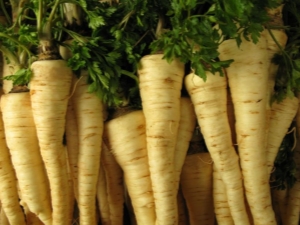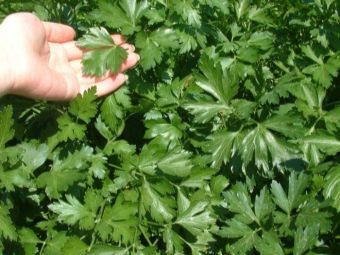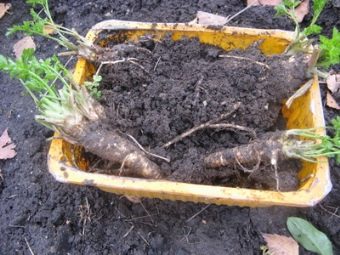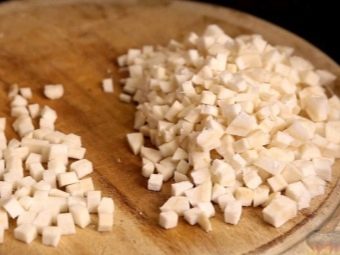Parsley root: properties, collection, storage and use

Parsley has long and deservedly gained popularity.Tart aroma and spicy taste allow you to use it for the preparation of many dishes. But parsley can use not only greens, but also the part that is underground, namely, the root.
Composition
It consists of many beneficial vitamins, micro-and macronutrients.
Vitamins per 100 g:
- PP - 1.3 mg;
- E (alpha-tocopherol) - 0.1 mg;
- C - 35 mg;
- B3 - 1 mg;
- B9 - 24 µg;
- B6 - 0.6 mg;
- B1 - 0.08 mg;
- B2 - 0.1 mg;
- A - 2 μg;
- beta carotene - 0.01 mg.
Content of mineral substances per 100 g:
- calcium - 57 mg;
- magnesium - 22 mg;
- sodium - 8 mg;
- potassium - 341 mg;
- phosphorus - 73 mg;
- iron - 0.7 mg.
100 grams contains proteins - 1.5 g, fat - 0.6 g, carbohydrates - 10.1 g. Calories are 51 kcal per 100 grams of product.
Also, 100 grams of parsley root contains mono- and disaccharides - 1.6 g, starch and dextrin - 4 g. These are digestible carbohydrates.
The parsley roots feature also in the fact that they contain a large amount of essential oils, the use of which for the body is undeniable.
In addition, the root contains dietary fiber, ash, starch, organic acids, fatty acids.
Useful and healing properties
Since parsley is rich in fiber at the root, its use has a beneficial effect on digestion and helps normalize stools.
Due to the significant content of vitamins, the product increases the body's resistance to diseases. The aging process slows down, normalizes metabolic processes. B vitamins have a positive effect on the nervous system.
- Calcium and phosphorus help strengthen bones and tooth enamel.
- Potassium is necessary for the body to work well in the cardiovascular system.
- Iodine has a significant effect on the thyroid gland.
- Magnesium stimulates the brain and, like vitamin B, strengthens the nervous system.
- Under the action of substances contained in parsley, the acidity of the stomach decreases and the blood sugar level normalizes.
- Parsley root is used in folk medicine as an adjunct in the treatment and prevention of many diseases.
- Due to the high content of beta-carotene, the plant is used to maintain visual acuity.
- Regular consumption helps to avoid cramps.
- Contributes to the suppression of the growth of pathogenic bacteria. Restores microflora in the intestines. Used to treat oral inflammations.
- Has antipyretic properties.
- Reduces the manifestation of allergic reactions.
- It is a strong diuretic, relieves swelling.
Contraindications and harm
Like any product, parsley root has contraindications.
You can not use the product if:
- there is an individual intolerance or allergic reactions to it;
- pregnant and lactating mothers;
- with inflammatory diseases of the kidneys and bladder, with kidney stones;
- in violation of the gallbladder and biliary tract;
- with calcification;
- children up to a year.
In these cases, the harm done to the body will outweigh the benefits.
Product selection, procurement and storage
When buying a root in a store or on the market, you should pay attention to the appearance and flavor of the product.
Root crop should be elastic, not dull. If the root is soft, then it was stored in inappropriate conditions. On it should not be cuts, stains, mold. The color is cream or white with a slight tinge of yellow. Small light brown specks are allowed. The aroma is saturated, a faint smell indicates a low quality product.
Parsley root can be prepared independently.
Parsley is harvested from mid-September, when the root has gained full weight. Harvest should be before the onset of frost. Dig parsley in dry and sunny weather.
The harvest process is simple:
- cut the greens so that there is a small stump;
- pull the roots out of the ground;
- briefly left to air to dry;
- prepare the roots for storage.
For harvesting for the winter and storage of parsley, there are several ways.
In the cellar
Choose healthy, intact roots and sort by size. Extra clods of earth shake off.
Save the harvest in the cellar in two ways.
- In sandboxes. Roots are placed in the prepared container, sprinkling layers of clean, slightly moist sand.
- Cut off the remnants of greenery and the tip of the roots, put them in bags. Without closing the bag, they fall asleep with a layer of five centimeters.
Frost
The product is thoroughly washed, cleaned, removing small shoots. Greens cut off completely. Next, chop the parsley. Can:
- cut into slices or cubes;
- mince;
- grind blender;
- rub on the grater.
The product is slightly dried, laid out on a napkin. Then lay out on plastic bags and, removing excess air, knotted.
Instead of conventional bags, you can use cling film or vacuum bags.
Drying
Root crop is cleaned the same as before freezing. Then cut into strips, slices or semicircular slices.
To dry the roots at home in several ways.
- On a baking sheet, covered with parchment, spread a thin layer of chopped roots. The baking tray is placed in a dry place where the sun's rays do not fall. Cover the baking sheet with gauze or parchment, leaving a hole for airing.
- Dry in the oven. The drying temperature is about forty degrees, the oven door should be ajar.
The dried product is removed in fabric bags or bags of thick paper. Store in a dark, ventilated area.
Pickling
Salting can be of two types.
- Salting in brine. The cleaned product is cut, as for drying, and scalded with boiling water. Placed in a small jar and pour brine. The brine is prepared as follows. Salt is added to a liter of water with scalded roots - 3 tablespoons with a slide, if the salt is shallow, and four spoons, if the salt is coarse. Pour the boiling brine over the contents of the cans, sterilize for 15 minutes and roll.
- Dry salting. Grated grated or chopped roots mixed with salt in a ratio of 5: 1. Put the workpiece in jars.
Salted parsley is stored in a cool, dark place. For example, in the cellar or in the refrigerator on the shelf for vegetables.
Application features
The scope of parsley root is very extensive. It can be used both in raw and in finished form. Using this white root to improve your health will only give positive results.
Due to its unique properties, it can be used:
- in cooking - to give the dishes a unique taste and aroma;
- in medicine - both in traditional and in folk;
- in cosmetology - It is an indispensable tool in the care of the skin of the face and body.
In cooking
This plant is an indispensable tool for cooking soups, second vegetable and meat dishes, salads. But it can be used as an independent dish.
In Greek cuisine, baked parsley root is cooked.
For cooking you need very few ingredients:
- 2-3 large parsley roots;
- a pinch of salt;
- on the tip of a teaspoon - ground pepper;
- 2-3 tablespoons of olive oil.
The root is cut into cubes, add salt and pepper, mix. Add olive oil and mix again. Bake in the oven until golden brown for 40 minutes at a temperature of 170-180 degrees.
In cosmetology
The plant is used to care for hair and skin.
With regular use of hair mask from the juice and decoction of the root can get rid of dandruff, reduce hair loss. Hair becomes healthy. Fragility disappears, luster and elasticity appear, volume increases. Regular rinsing the hair with a decoction of parsley root stimulates hair growth and gives it shine.
The basis for the mask is chosen, taking into account the type of hair.
For dry and brittle mask is well suited on the basis of olive oil. Honey, olive oil and decoction of the roots are taken in the same proportion. All mixed and heat applied to the hair.Hold the mask for half an hour, then wash and rinse the hair with a decoction of the roots. Honey can be replaced with whipped egg yolk.
For oily hair, low-fat kefir is added to the herbal decoction. Make it the same as a mask for dry hair.
Parsley is an indispensable tool for skin care. Broths and masks based on parsley root are suitable for any skin type. Helps to remove swelling, smooth wrinkles, give a fresh, healthy look to tired skin. White root in the composition of skin care products helps to lighten the pigment spots and freckles.
White root products are applied to cleansed and steamed skin. The mask is on the face for about half an hour, after which it is washed off with warm water and cream is applied.
In folk medicine
Parsley root is used for the treatment and prevention of various diseases. It is also used as a means for losing weight. In this case, it is used both in raw form (for salads), and in dried or frozen (for preparing infusions and decoctions). Parsley normalizes the metabolism in the body, helps to remove excess fluid and puts in order digestion. All these factors help to lose weight and improve health.
Healing recipes
Infusions and decoctions of the root are made both for external use and for ingestion. Infusion is often used in diets for weight loss.
Infusion
You can make the infusion in two ways - cold and hot.
- Cool way. One tablespoon of chopped root is poured over with two hundred grams of cold water. Covering with a lid, insist in a dark place for 10-12 hours. With this method of preparation, most of the vitamins and essential oils remain unchanged.
- Hot way. For hot infusion you need the same amount of ingredients, only water is taken not cold, but boiling water. Insist hot infusion should be about an hour. It is best to do the infusions in a thermos, so they are more saturated. Before use, infusion filter. Take the infusion half an hour before meals no more than three times a day, 50 ml.
Decoction
In order to prepare the broth, a tablespoon of raw materials is poured 250 ml of hot water and kept on the fire, without boiling, for ten minutes. Next filter. Take a decoction twice a day, 100 ml thirty minutes before meals or three hours after meals.
Tea
It is prepared the same way as an infusion, but the cooking time is much less. 250 ml of boiling water take a tablespoon of chopped root and insist fifteen minutes. Tea is ready to drink.
For information on the properties of parsley root, see the following video.



































